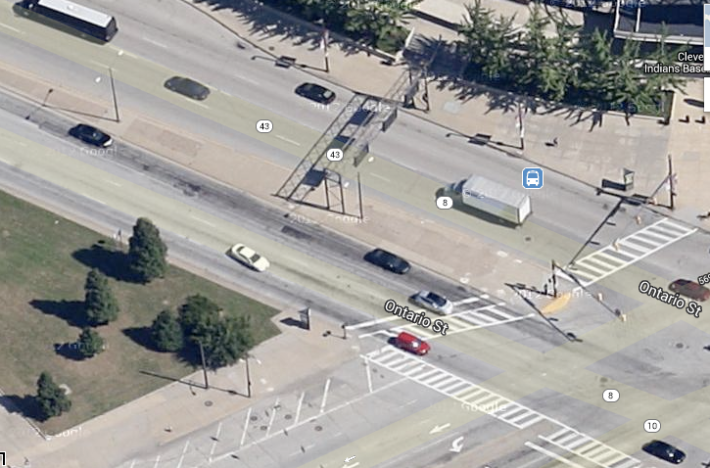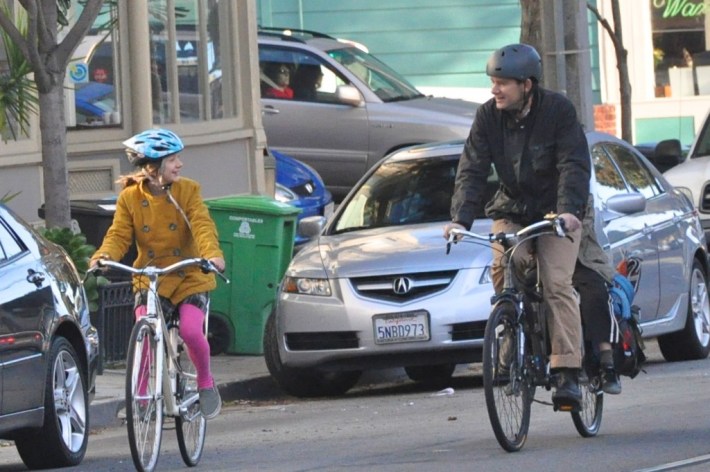If Ontario Street in Cleveland, Ohio, is any indication, a complete streets policy is no guarantee you'll get a safe place to ride a bike, or even a comfortable place to walk.

Ontario is one of those roads designed to simply funnel traffic to and from a highway -- and in fact there's not much to distinguish the street from a highway. It's eight lanes wide and devoid of landscaping, or any obstacles to fast driving, really. The most tragic part is, it's right in front of where the Indians play, Progressive Field, which was sold to taxpayers as a way to enliven the city.
This road just came up for resurfacing, and with the city's complete streets policy, now two years old, it seemed like an ideal time to correct this mistake. Instead, Cleveland's traffic engineering department punted, leaving the road basically as is but adding shared lane bike stencils, or sharrows. (Actual bike lanes would compromise the street's ability to accommodate cars during rush hour, you see.)
And there you have it. A complete streets policy should be a fabulous thing that elevates safety, the economy, and social equity in cities, but it can also amount to nothing more than a few new rules that are easily ducked if officials don't want to follow the spirit of the law.
Some 500 communities and states across the United States now have complete streets policies, so the good work of enacting these laws is well underway. Implementation is the next frontier.
And it's not easy, especially in communities like Cleveland where these ideas still feel new. But some cities are doing a better job than others, says Stefanie Seskin at the National Complete Streets Coalition. Charlotte, for example, developed six key steps to the project development process. Seattle passed a special tax levy to help support safe streets improvements for active transportation. San Francisco, in its “Better Streets” guide, prioritizes pedestrian concerns.
"The cities that I listed are leaders because they’ve changed a lot in their decision-making process," says Seskin. "It’s not like sexy and you don’t have pretty pictures, but when you set a goal for an agency and you realign practices to achieve that goal, I think that makes a big difference."
Cleveland, meanwhile, has a complete streets task force, but in practice the decisions still lie with the Department of Traffic Engineering -- the same folks who designed an at-grade highway for the front of the city's baseball stadium.

Having good city staff -- people who are committed to seeing complete streets implemented and understand why it's important -- is crucial. Or, like Charlotte, you can develop and train a working group or committee to oversee the process.
"You have a lot of people that have been around for years that are used to doing things the way they have been doing them," Seskin said. "You have to change the problem and make them understand they’re solving for a new problem."
Another key element is performance measures. What does success look like? Boulder, Colorado, set a goal in the 1990s to reduce traffic. Since then, the city has invested heavily in transit and reduced the percentage of trips taken by car, said Seskin. Indianapolis incorporated a lot of easily “countable” performance measures into its complete streets plan, including the percentage of children walking or biking to school and the number of transit stops that are accessible with sidewalks and curb ramps.
If decision makers in your city are still under the impression that moving cars is the most important factor in street performance, your streets probably won't get a whole lot safer. But some progress is possible even if cities still try to accommodate "peak hour" traffic. Charlotte, for instance, decided to define "peak hour" as the full two hours around rush hour, not the most congested 15 minutes during that period. As a result, they didn't consider it so imperative for streets to be dangerously wide.
Cities should also be sure to update their design guides. Many communities, after passing complete streets ordinances, develop design manuals that serve as a rough guide for the physical geometry of streets across the city. That way, safety improvements can be applied according to a consistent set of principles whenever streets are repaved, instead of starting from scratch with every street.
"Then, every time a project comes up, it's not a question of whether this is going to be a complete street or not," said Seskin. "It’s, 'How can we accommodate all these users.'"





